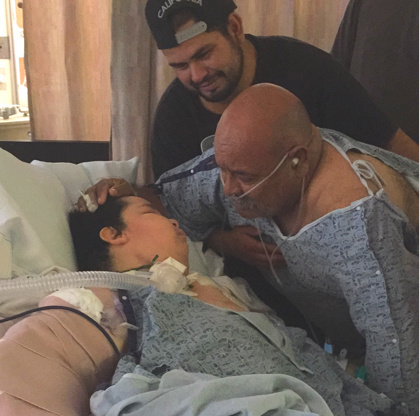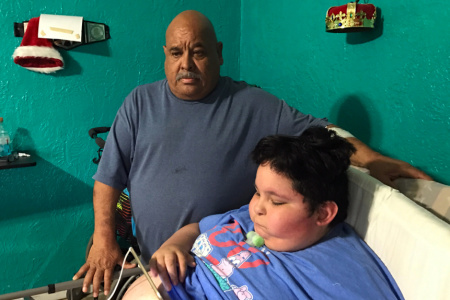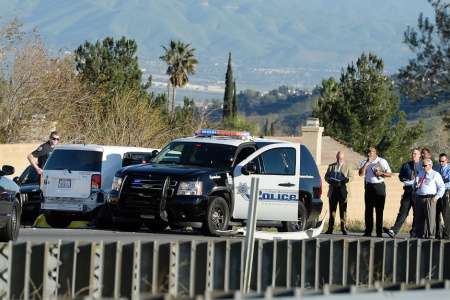In San Bernardino County, officers take aim at moving cars
Jose Villegas, his wife and son were headed home on the 215 freeway after a shopping excursion when an S.U.V. came hurtling at the family’s Dodge Durango.
There was little time to react.
“Boom!” Villegas said. “It was like an explosion.”
Not far away, a San Bernardino County Sheriff’s Department helicopter buzzed in the air, trailing a robbery suspect in the S.U.V.
He had been driving at speeds exceeding 100 mph - in the wrong direction.
From the helicopter, Deputy Paul Kowalski carefully aimed down at the fleeing S.U.V. According to Villegas’ lawyer, the S.U.V. was on the shoulder, not a lane of traffic when Kowalski sprayed 80 bullets down on the freeway at the unarmed driver. The suspect, Nicholas Johnson, was killed. His S.U.V. smashed into the family’s Durango.

Villegas broke a leg. His wife Maria’s ribs were cracked, her wrist broken and her stomach bled. Moments after the wreck, Villegas heard his disabled 13-year-old son cry out from the back seat.
“Mom, help!” Villegas recalled the boy calling out. His son was injured, too.
At a time of national discussion about police shootings, department leaders around the country have identified strict policies about firing into cars as a simple way to reduce lethal force – and preserve human life.
Agencies from Los Angeles to Denver to New York have banned shooting into moving vehicles and tell their officers to get out of the way unless the suspect poses a threat beyond running them over, according to an earlier KPCC investigation and news reports.
That’s because shooting at a car is inherently dangerous – it can go out of control, hurting bystanders or the officers.
But the practice continues at law enforcement agencies in San Bernardino County.
LAW ENFORCEMENT SHOOTING INTO CARS, BY COUNTY
Officers in San Bernardino County shot into moving cars at nearly double the rate of Los Angeles County.

An investigation by KPCC and The San Bernardino Sun found officers there shoot into moving cars at nearly double the rate of neighboring Los Angeles County. In 70 percent of the San Bernardino County cases, the person shot in the car was unarmed.
The San Bernardino County Sheriff’s Department maintains they shot into the speeding S.U.V. that slammed into the Villegas family in order to protect drivers on the freeway since the car was heading against traffic.
“The deputies needed to protect the public and prevent injuries,” Deputy Olivia Bozek, spokeswoman for the sheriff’s department said following the deadly shooting.
In a written statement, San Bernardino Sheriff John McMahon pointed out that last year his deputies made more than 32,000 arrests and were only involved in nine shootings.
“Their priority is to rush toward chaos to protect innocent lives, and they must be prepared to defend themselves and others by making split-second decisions,” he said.
Captain Robert O’Brine heads the department’s training division and said the department re-examined its tactics after the crash.
“I can tell you that the helicopter policy has not been revised,” he said.
“We discourage people from shooting into moving vehicles because of the dangers associated with it,” he said. “But our officers are not prohibited from using it if the need arises.”

Villegas sees it differently.
“They need to change - change the tactic,” he said as he stood next to his son Aldo Villegas’ medical bed in the living room of the family’s small home in San Bernardino. Aldo thumbed through a Power Rangers game on a tablet.
Aldo was born with disabilities that had already made getting around difficult. Before the crash, he needed crutches. Now, he said, it’s worse.
“I can’t walk anymore,” the boy said.
The Villegas family filed a negligence lawsuit and claims the injuries that resulted from department’s actions will cost the family millions of dollars in health care, according to their attorney.
FREQUENT CAR SHOOTINGS
KPCC and The San Bernardino Sun’s investigation found officers from agencies around San Bernardino County shot into moving vehicles and hit suspects at least 14 times in the span of six years. It’s unknown how many times they may have shot and missed. The district attorney does not review police shootings unless someone was injured.
The analysis is based on San Bernardino County District Attorney records of officer shootings from 2010 through 2015, collected by KPCC and The San Bernardino Sun through public records requests. Some shootings are not included, as the district attorney is still reviewing the case, so it’s possible the final number will be higher than 14. The case involving the Villegas family is still under review.
The investigation shows more than 75 percent of the San Bernardino County car shootings involved suspected car thieves or drivers who committed traffic violations.
“It is extremely dangerous when the police get into a gunfight with someone when they’re driving down the street, because basically you endanger citizens who are pedestrians or other occupants in other cars,” said Larry Gaines, a professor of criminal justice at Cal State San Bernardino.
“But I guess there are a few occasions where the police have to do that, especially in cases where people are in danger or threatened,” he added.
He suggested agencies instead try alternatives like spike strips that can be laid on the road to disable cars more safely.
CIRCUMSTANCES OF VEHICLE SHOOTINGS
Most moving vehicle shootings in San Bernardino County involved motorists suspected of car theft or traffic violations.

KPCC and The Sun found car shootings make up a particularly large portion of police shootings in two cities in San Bernardino County. Thirty percent of Fontana’s police shootings involved shooting into cars.
In the city of Colton, the percentage was forty.
At that moment, the officer has to make that life or death decision of whether he’s going to go home that night.
SHOOTING UNARMED DRIVERS IN COLTON
One typical case: In 2010, a Colton police officer tried to stop a minivan for allegedly running a red light. The driver, David Romero, didn’t pull over. A chase ensued and other officers joined in.
They cornered the driver in an apartment complex parking lot. Officers swung open the doors of their patrol cars and approached Romero. Romero put the van in reverse and hit the gas.
Two of the officers present said they feared being run over and opened fire to neutralize the threat. They squeezed off 15 rounds – 13 of which pierced the van, some traveling clean through from one side to the other.
Romero died of a single gunshot wound to the head. He was 19 years old and unarmed, according to district attorney records, which concluded the officers did not violate criminal laws and should not be prosecuted.
Another instance in 2012 began when three Colton officers spotted a car that had been reported stolen. They pulled up behind a Honda Accord, boxing in the driver, Tremayne Williams, and his female passenger.
Officers got out of their squad cars to confront the suspected car thief. Williams threw the Honda in reverse, striking a police S.U.V. According to district attorney records, officers said they feared they’d be run over and fired several times at the driver.
The shots killed Williams and injured the female passenger – the woman who district attorney records show didn’t threaten anyone.
Williams’s family filed a lawsuit against the department and settled for $237,000.
Colton police said none of the shootings in KPCC and The Sun’s database were found to be out of policy.
ARMED vs. UNARMED
The majority of people shot in moving cars in San Bernardino County were unarmed.

Officials with that department and two other law enforcement agencies interviewed by KPCC and The Sun acknowledged the dangers of shooting into moving cars. Yet, even after being presented with the numbers of shootings of unarmed drivers, none of the officials interviewed said they would ban the practice.
“If they have to happen, they have to happen, unfortunately,” said Colton Chief of Police Mark Owens.
“At that moment,” Owens said, “the officer has to make that life or death decision of whether he’s going to go home that night.”
By contrast, Los Angeles County Sheriff’s officials last year instituted a ban at shooting unarmed people in moving vehicles after an investigation by KPCC found deputies had shot eight unarmed people in moving vehicles in a five-year period.

CHASING STOLEN CARS
KPCC and The San Bernardino Sun’s investigation found in nine of fourteen shootings in the county officers engaged in a car chase with the suspect.
CAR CHASES AND VEHICLE SHOOTINGS
In nine of 14 shootings, officers engaged in a car chase with the suspect.

In San Bernardino, officers fatally shot Jonathan Harden after chasing him in a stolen car.
In February 2015, district attorney records show Harden spotted a Scion with the engine running in front of nursing home in Banning and hopped in. San Bernardino police got on his tail, trailing him as he drove 100 mph and crashed into several cars, including a patrol vehicle.
After Harden’s car spun out of control, officers said they feared his car was coming directly for them and fired 25 rounds. Harden was pronounced dead at the scene, his body carted away to a medical examiner.
Harden may have feared being discovered for drug possession. A pathologist found he was hiding a glass pipe and a white substance inside his body.
“I don’t doubt that he may have been on some sort of drugs or alcohol,” said Harden’s father, Jim Harden. He understood why officers would stop his son, but didn’t think it needed to escalate to lethal force.
“He wasn’t in a good place,” Jim Harden said.
You have another stolen car. You have another warrant. … It’s not worth either the officer getting hurt over or the suspect dying over.
Using lethal force in these types of situations is disproportionate to the initial crime, said Chuck Wexler, executive director of the Police Executive Research Forum, a think tank which some in law enforcement consider left-leaning.
Wexler said if someone suspected of a property crime is getting away, it’s time to get an arrest warrant.
“You have another stolen car. You have another warrant. That’s not the end of the world,” Wexler said. “It’s not worth either the officer getting hurt over or the suspect dying over.”
Law enforcement officials in Oakland and Dallas agree. They have sought to limit when their officers engage in car chases at all, arguing that they are not always necessary to apprehend suspects and create risky, dangerous situations for officers – and the public.
It’s the same argument other cities have used to heavily curtail shooting into cars.
When Fontana police fatally shot Mahanad Shalabi, 41, in the head in 2011, the stolen car he was driving accelerated, jumped a curb and collided into a nearby home. District attorney documents do not indicate whether anyone inside was hurt.
Shalabi was unarmed.
Shalabi’s family filed an excessive force lawsuit against the city and declined to comment, citing pending litigation. Fontana officials wouldn’t talk about the case either.
But district attorney records show Shalabi had gone into two car dealerships in May 2011 and talked the salesmen into letting him test out the vehicles. The cars never came back.
He was driving one of them when police found him.
One witness told investigators the officer who shot, Jason Pernicairo, was 30 feet behind Shalabi’s fleeing car when he opened fire.
Another witness told them: The officer, Jason Pernicairo, “shot because the suspect was getting away from him and not because he was in danger.” According to the district attorney records, that witness’s account was discarded as inaccurate.
Fontana police spokesman Sergeant Kevin Goltara said his department is reluctant to limit use of force for fear it would hamstring officers in potentially dangerous situations.
“No officer that I know of just goes out there and says I want to shoot people,” Goltara said. “That’s not what we’re in the business for.”



